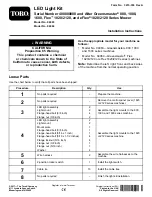
1
g021215
Figure 29
1.
Hydraulic-tank cap
3.
Remove the dipstick from the filler neck and wipe it
with a clean rag. Insert the dipstick into the filler neck,
then remove it and check the level of the fluid. The
fluid level should be within 6.3 mm (1/4 inch) of the
mark on the dipstick. Do not overfill the tank.
4.
If the level is low, add the appropriate fluid to raise the
level to the full mark.
5.
Install the dipstick and the cap onto the filler neck.
Checking the Reel to Bedknife
Contact
Each day before operating, check reel to bedknife contact,
regardless if the quality of cut had previously been acceptable.
There must be light contact across the full length of the reel
and the bedknife (refer to Adjusting the Reel to Bedknife in
the cutting unit
Operator's Manual
).
Checking the Torque of the
Wheel Nuts
Torque the wheel nuts to 94 to 122 N-m (70 to 90 ft-lb)
after
1 to 4 hours
of operation and again after
10 hours
of
operation. Torque them every
250 hours
thereafter.
WARNING
Failure to maintain proper torque of the wheel nuts
could result in personal injury.
Maintain proper torque of the wheel nuts.
Starting and Stopping the
Engine
Starting the Engine
1.
Sit on the seat, keep your foot off of the traction pedal
so that it is in Neutral, engage the parking brake, set the
engine speed switch to the Mid position and ensure that
the Enable/Disable switch is in the Disable position.
2.
Remove your foot from the traction pedal and make
sure the pedal is in the Neutral position.
3.
Insert and rotate the ignition key clockwise until the
engine starts.
Stopping the Engine
1.
Move all controls to Neutral, set the parking brake,
move the engine speed switch to the low idle position
and allow the engine to reach low idle speed.
2.
Turn the key to the Off position and remove it from
the switch.
Setting the Reel Speed
To achieve a consistent, high quality of cut and a uniform
after cut appearance, it is important that you set the reel speed
to the proper setting. Adjust the reel speed as follows:
1.
In the InfoCenter, enter the blade count, mow speed
and HOC to calculate the proper reel speed.
2.
If further adjustments are required, scroll down on the
InfoCenter to the F Reel RPM, R Reel RPM, or both.
3.
Press the right button to change the reel speed value.
As the speed setting is changed, the display continues
to show the calculated reel speed based on blade
count, mow speed, and HOC, but the new value is
also displayed.
Note:
The reel speed may need to be increased or
decreased to compensate for varying turf conditions.
Adjusting the Lift Arm
Counterbalance
You can adjust the counterbalance on the rear cutting unit
lift arms to compensate for different turf conditions and to
maintain a uniform height of cut in the rough conditions or
in areas of thatch buildup.
You can adjust each counterbalance spring to 1 of 4 settings.
Each increment increases or decreases counterbalance on the
cutting unit by 2.3 kg (5 lb). The springs can be positioned
on the back side of the first spring actuator to remove all
counterbalance (fourth position).
1.
Position the machine on a level surface, lower the
cutting units, stop the engine, engage the parking
brakes, and remove the key from the ignition switch.
26
Содержание 03673 Reelmaster 5410-G
Страница 47: ...Notes 47 ...
















































